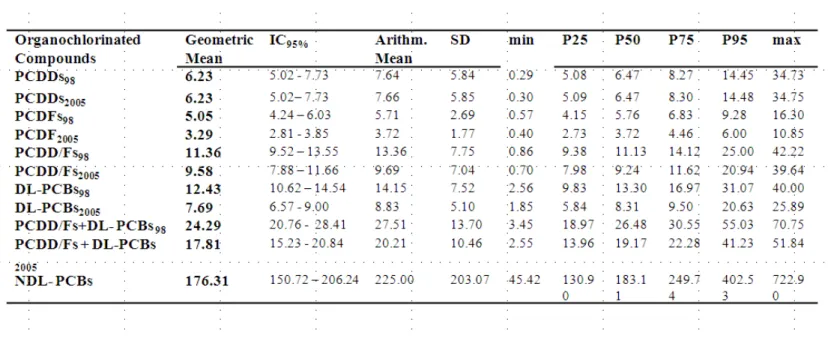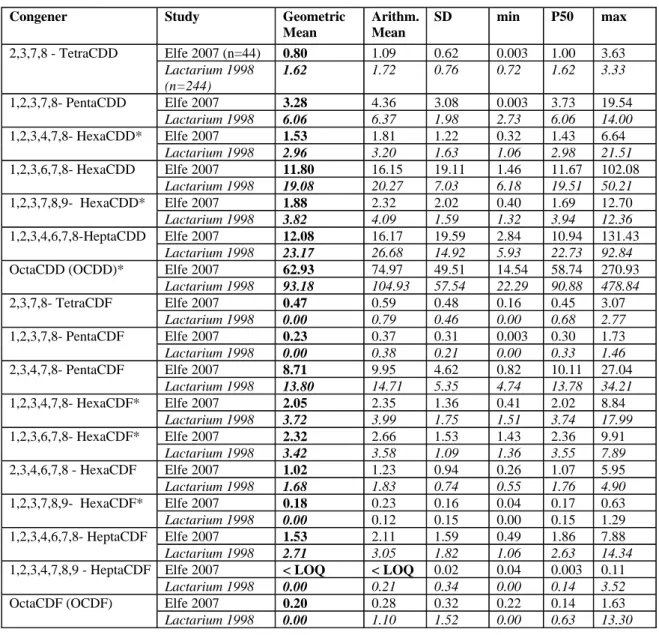DIOXINS IN HUMAN MILK FROM DIFFERENT REGIONS OF FRANCE: PILOT OF
THE FRENCH LONGITUDINAL STUDY OF CHILDREN (ELFE)
Vandentorren S1, Frery N1, Bidondo ML1, Eppe G2, SchollG2, De Pauw E2, Saoudi A1, Oleko A1, Focant JF2
1Institut de Veille Sanitaire (INVS), Département Santé Environnement,12 rue du Val d’Osne, 94415 Saint-Maurice cedex, FRANCE
2CART, Mass Spectrometry Laboratory, University of Liège, Allée de la Chimie 3, B-6c Sart-Tilman, B-4000 Liège, BELGIUM (JF.Focant@ulg.ac.be)
Introduction
French exposure to dioxins in the population is still a matter of concern. Dioxins have deleterious effects on immunity, development, nervous system, thyroid, reproduction and metabolism. Furthermore, 2,3,7,8-TCDD is carcinogenic and other congeners could be endocrine disruptors. Even if policy actions have been taken to reduce exposure of the population on industrial and incinerator emissions, the persistency of these compounds in environment makes human biomonitoring still relevant in particular in pregnant women. One of the objectives of the Elfe study (French longitudinal Study since the childhood) is to measure pollutant exposures of delivered mothers in order to estimate a national exposure level to dioxins. A pilot study was set up in 2007 to test the recruitment, the interview procedures and the biological sampling of the final study.
The present work focused on PCDD/F and DL-PCB levels in the milk of a representative population of a county in the east of France sampled in 2007 during this pilot. The set of tested compounds consisted in 35 compounds: seven 2,3,7,8-substituted PCDDs, ten 2,3,7,8-substituted PCDFs, 12 DL-PCBs (four non-ortho-PCBs, eight mono-ortho-PCBs) and six NDL-PCBs. The current Elfe data have been compared with a previous French study conducted In 1998-99, on 244 mothers and with foreign data.
Materials and Methods
The Elfe pilot took place in 4 French counties: Ardèche, Isère, Loire, and Savoie for all births occuring during four days in 2007. Between the 6th and 8th weeks after delivery milk was collected for each breastfeeding mothers at home using a specific bottle in glass given to participants at the maternity. All participants were joined by phone one month after leaving the maternity to explain carefully how to properly collect breastmilk and ship specimen for storage in a centralized biobank before analysis. This pooled sample container was shipped by mail in waterproof pre-labeled box to the biobank where samples were stored at -20°C until they were shipped with dry ice to the laboratory for measurement. Since a third of mothers continue to breastfeed after one month, a total of 44 samples of 150 mL of breastmilk was collected.
For each sample of milk, 30 mL was used for a liquid-liquid extraction and then analyzed by GC–HRMS. Measurements of mono-ortho-PCBs and NDL-PCBs were carried out on a MAT95 XL (ThermoFinniganMAT, Bremen, Germany). Measurements of PCDDs, PCDFs, and non-ortho-PCBs were carried out on an Autospec Ultima (Micromass, Manchester, United Kingdom). Both instrumental and procedural blanks (BCs) were monitored. All samples were processed in series of routinely analyzed samples (one method blank, one instrumental blank, one QC and 10 unknown) in an ISO17025 BELAC accredited laboratory.
For statistical analysis, log-transformations for milk levels of dioxins furans and PCBs were used, since the preliminary investigation indicated that milk dioxins, furans and PCBs levels were consistent with a lognormal distribution.
Results and Discussion
Mothers were aged from 24 to 41 years old (mean and median: 32 years) and 25 % were primiparous, 25% secundiparous, 27% tertiparous and 23% quadriparous or more. For total TEQ (PCDD/Fs and DL-PCBs), the geometric mean concentration was 24.25 pg TEQ/g lipids if expressed in WHO1998-TEQ and 17.74 in WHO2005-TEQ. PCDDs were 78% of PCDD/Fs in 2005 versus 50% in 1998. For the sum of the 6 NDL-PCBs, the geometric mean concentration in milk was 176.3 ng/g lipids. The mean of fat in breast milk was 25.1 g/L (range from 6 to 46.7 g/L) (Table 1).
In 1998-99, a French study conducted in lactariums present in the whole territory (centers where mothers give their breastmilk) gave the first results on dioxin concentrations in France (n=244). The geometric mean concentration of PCDD/Fs in 1998 was 18.8 pg TEQ-WHO1998/g lipids (10.6 pg TEQ/g for PCDDs and 7.95 pg TEQ/g for PCDFs). When compared with the recent data obtained from the Elfe pilot study, the PCDD/F concentrations have decreased. Mean PCDD TEQ levels vary more than do PCDF levels. The mean of PCDD/F has decreased of about 39.4 % (18.8 pg TEQ/g lipids in 1998 vs 11.4 pg TEQ/g lipids in 2007), of 41.5 % for PCDD (10.6 pg TEQ/g lip in 1998 vs 6.2 pg TEQ/g lip in 2007) and of 36.5 % for PCDF (7.95 pg TEQ/g lip in 1998 vs 5.05 pg TEQ/g lip in 2007).
French dioxin levels are similar to those observed abroad in Europe, but higher than in Australia. National Elfe study will provide the first national reference values for pregnant women in 2012-2013.
Based on milk consumption in France, for a baby of 5 kg feeding daily with 700 mL of breastmilk with about 25 g/L of lipids, the daily intake of PCDD/Fs and DL-PCBs is equal to 62.3 pg TEQWHO2005/Kg body weight.
In 1998-99, a French study conducted in lactariums present in the whole territory (centers where mothers give their breastmilk) gave the first results on dioxin concentrations in France. A total of 244 milk samples for dioxin analysis were collected from mothers who also completed a questionnaire giving information on various factors influencing the levels. The geometric mean concentration of PCDD/Fs in 1998 was 18.8 pg TEQ-WHO1998/g lipids (10.6 pg TEQ/g for PCDDs and 7.95 pg TEQ/g for PCDFs). The comparison between the both studies is presented for the different congeners in the Table 2. When compared with the recent data obtained from the Elfe pilot study, the PCDD/F concentrations have decreased. Mean PCDD TEQ levels vary more than do PCDF levels. The mean of PCDD/F has decreased of about 39.4 % (18.8 pg TEQ/g lipids in 1998 vs 11.4 pg TEQ/g lipids in 2007), of 41.5 % for PCDD (10.6 pg TEQ/g lip in 1998 vs 6.2 pg TEQ/g lip in 2007) and of 36.5 % for PCDF (7.95 pg TEQ/g lip in 1998 vs 5.05 pg TEQ/g lip in 2007).
Table 1. Distribution of PCDDs, PCDFs and DL-PCBs in pg TEQ/g lipids (TEQ 1998 and 2005) and the sum of the 6 NDL-PCBs in ng/g
lipids
Table 2. Comparison of the PCDD/F congener concentrations in two French studies (Lactarium study (1998-99) and Elfe pilot study (2007) in pg /g lipids
Congener Study Geometric
Mean Arithm. Mean SD min P50 max 2,3,7,8 - TetraCDD Elfe 2007 (n=44) 0.80 1.09 0.62 0.003 1.00 3.63 Lactarium 1998 (n=244) 1.62 1.72 0.76 0.72 1.62 3.33 1,2,3,7,8- PentaCDD Elfe 2007 3.28 4.36 3.08 0.003 3.73 19.54 Lactarium 1998 6.06 6.37 1.98 2.73 6.06 14.00 1,2,3,4,7,8- HexaCDD* Elfe 2007 1.53 1.81 1.22 0.32 1.43 6.64 Lactarium 1998 2.96 3.20 1.63 1.06 2.98 21.51 1,2,3,6,7,8- HexaCDD Elfe 2007 11.80 16.15 19.11 1.46 11.67 102.08 Lactarium 1998 19.08 20.27 7.03 6.18 19.51 50.21 1,2,3,7,8,9- HexaCDD* Elfe 2007 1.88 2.32 2.02 0.40 1.69 12.70 Lactarium 1998 3.82 4.09 1.59 1.32 3.94 12.36 1,2,3,4,6,7,8-HeptaCDD Elfe 2007 12.08 16.17 19.59 2.84 10.94 131.43 Lactarium 1998 23.17 26.68 14.92 5.93 22.73 92.84
OctaCDD (OCDD)* Elfe 2007 62.93 74.97 49.51 14.54 58.74 270.93
Lactarium 1998 93.18 104.93 57.54 22.29 90.88 478.84 2,3,7,8- TetraCDF Elfe 2007 0.47 0.59 0.48 0.16 0.45 3.07 Lactarium 1998 0.00 0.79 0.46 0.00 0.68 2.77 1,2,3,7,8- PentaCDF Elfe 2007 0.23 0.37 0.31 0.003 0.30 1.73 Lactarium 1998 0.00 0.38 0.21 0.00 0.33 1.46 2,3,4,7,8- PentaCDF Elfe 2007 8.71 9.95 4.62 0.82 10.11 27.04 Lactarium 1998 13.80 14.71 5.35 4.74 13.78 34.21 1,2,3,4,7,8- HexaCDF* Elfe 2007 2.05 2.35 1.36 0.41 2.02 8.84 Lactarium 1998 3.72 3.99 1.75 1.51 3.74 17.99 1,2,3,6,7,8- HexaCDF* Elfe 2007 2.32 2.66 1.53 1.43 2.36 9.91 Lactarium 1998 3.42 3.58 1.09 1.36 3.55 7.89 2,3,4,6,7,8 - HexaCDF Elfe 2007 1.02 1.23 0.94 0.26 1.07 5.95 Lactarium 1998 1.68 1.83 0.74 0.55 1.76 4.90 1,2,3,7,8,9- HexaCDF* Elfe 2007 0.18 0.23 0.16 0.04 0.17 0.63 Lactarium 1998 0.00 0.12 0.15 0.00 0.15 1.29 1,2,3,4,6,7,8- HeptaCDF Elfe 2007 1.53 2.11 1.59 0.49 1.86 7.88 Lactarium 1998 2.71 3.05 1.82 1.06 2.63 14.34
1,2,3,4,7,8,9 - HeptaCDF Elfe 2007 < LOQ < LOQ 0.02 0.04 0.003 0.11
Lactarium 1998 0.00 0.21 0.34 0.00 0.14 3.52
OctaCDF (OCDF) Elfe 2007 0.20 0.28 0.32 0.22 0.14 1.63
Lactarium 1998 0.00 1.10 1.52 0.00 0.63 13.30

